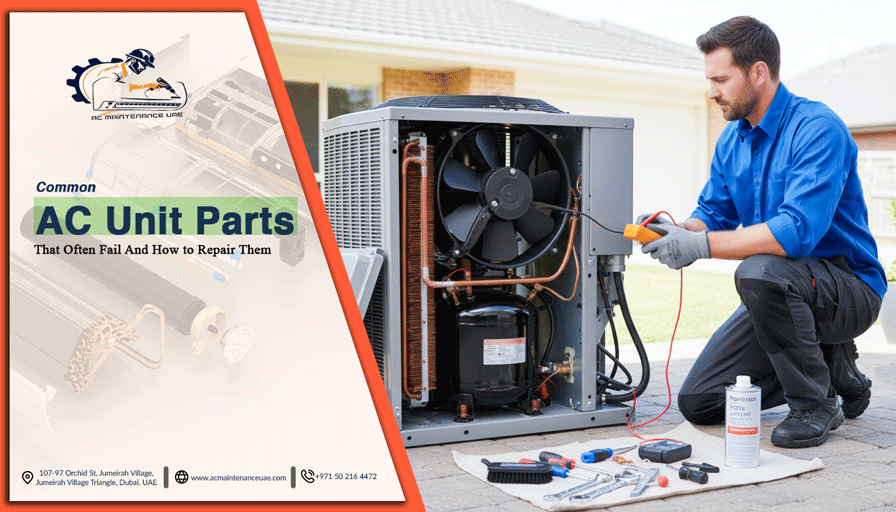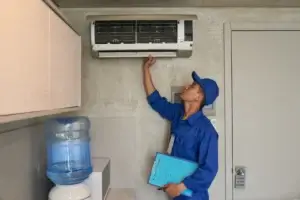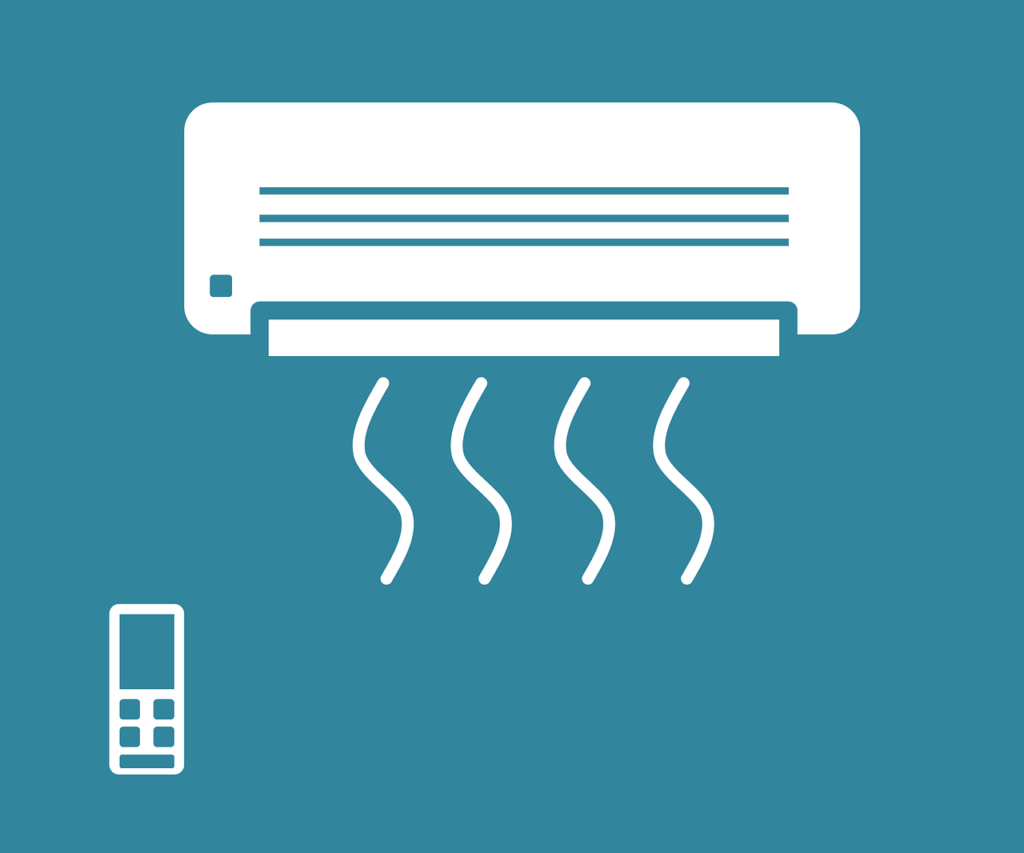Does your air conditioner make strange noises, or does it not work at the right temperature? This knowledge will save you hundreds of dirhams in urgent work and avoid unpleasant summer days because you know the AC unit parts that can break. This manual shows the most sensitive HVAC components in your cooling system, red flags of failure, and effective repair options that will ensure that your home is comfortable all year long.
Why AC Unit Parts Fail Over Time
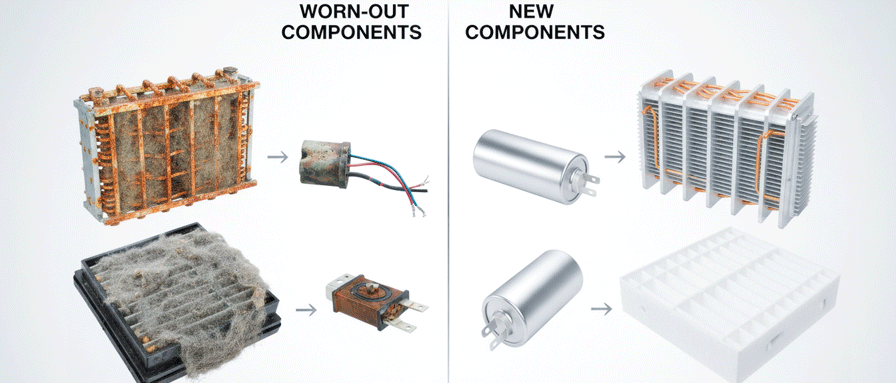
All cooling systems wear out due to continuous use. Knowledge of the causes of component deterioration will allow you to avoid failures and increase the life of your unit with correct maintenance.
The Importance of Understanding AC Unit Parts
There are dozens of parts related to your cooling system that interact to control temperature. The failure of one component causes a ripple effect that places strain on other components of the air conditioner in the system.
The majority of homeowners are unaware that 80 percent of AC failures are caused by only five major parts. These sensitive sections are perpetually worn out by changes in temperature and mechanical forces.
How Regular Maintenance Prevents Early Damage
Preventive care also increases the life of important HVAC system components by dealing with small problems before they deteriorate. Minor activities such as the replacement of an ac filter every month lower the failure rates tremendously.
When the parts are not kept clean, dirt grows and compels the parts to work harder, thus consuming more energy. Early warning signs can be detected by professional technicians that cannot be detected by the untrained eye.
Overview of Essential AC Unit Parts in Every Cooling System

The modern air conditioning system is based on a number of mechanical and electrical parts working together. It is important to understand how these components work together to diagnose them and communicate with technicians.
The Role of Major HVAC System Components
All air conditioning systems depend on four basic cycles, which are compression, condensation, expansion, and evaporation. The compressor, condenser, expansion valve, and evaporator coil are collaborative parts that enable the movement of heat from the interior of your home to the exterior.
Parts of the HVAC should be able to retain specific pressure and temperature conditions during these cycles. The refrigeration process becomes inefficient when one of its components fails.
Identifying Key Cooling System Parts in Modern ACs
The important cooling system components are:
- Compressor: Forces refrigerant into the system and pumps it.
- Condenser coil: Is releasing the heat that accumulated in the interior air.
- Evaporator coil: It absorbs the indoor air heat.
- Expansion valve: Controls the flow of refrigerant.
- Blower motor: Helps in the circulation of air by use of ductwork.
Common AC Unit Parts That Fail Most Frequently

Some of the components have higher rates of failure because of their heavy-duty operation. Knowing these weak areas will assist you in keeping watch over your system and preventing some failures before they go overboard.
- Compressor: The Cooling System Stomach.
The compressor is the largest replacement cost, which is usually AED 5,500 to 9,000, labor inclusive. Among the indicators of failure, one can single out loud grinding noises and the operating unit being without cooling.
- Condenser Coil: It is Dirty and prone to Overheating.
Coils in condensers get dirty and collect debris, thus limiting the flow of air, leading to overheating. Regular ac coil cleaning can be used to remove obstructions that cause a loss of proper heat transfer.
- Evaporator Coil: Prone to Refrigerant Leaks.
Corrosion leads to leaks in the indoor evaporator coils, which cause a slow leakage of refrigerant in the evaporator. Formation of ice means that there is limited air flow or that there is low refrigerant content that demands expert services.
- Contactors and Capacitors: Typical Electric Failures.
Capacitors are an electrical storage device used to activate motors and can be expected to last 10-20 years. The humming sounds, slow starts, and arbitrary shutdowns with the necessity to replace them immediately are considered signs of failure.
- Fan Motor and Blower: Air Circulation Problem.
Fan motors are subjected to severe weather conditions, which accelerate the wear of bearings. Strong grinding or bad airflow depicts the issues with the motor that require lubrication or replacement.
- Thermostat: Cooling Control Problems.
The malfunction of thermostats happens because of dead batteries or loosening of wires, or dust. Placing it wrongly in areas with a heat source produces false readings, which initiate unnecessary cooling cycles.
Warning Signs Your AC Unit Parts May Be Failing
Detecting component failure early can prevent expensive failures and prolong the life of the system. Once you learn the warnings, you’ll be able to address issues before repairs turn into emergencies.
- Unusual Noises / Vibration
Grinding can signal bearing problems. Clicking normally indicates electrical issues. Hissing is most likely a leak in the refrigerant. Rattling is typically a loose piece of hardware or debris inside the unit.
- Weak Airflow / Unconventional Cooling
Less airflow likely indicates blower motor issues, leaking ductwork, or a severe restriction in airflow due to the filter. Some rooms being warmer can indicate duct problems or blocked vents.
- Leaks, Odors, and Electrical Smells
Water pooling can indicate clogged drains. Sweet chemical smells can indicate refrigerant leaks. Electrical smells of burning can indicate potential fire hazards, and the unit should be shut off for immediate safety reasons.
- Higher Energy Costs / Short Cycling
If the cooling cost has increased quickly in a short amount of time, the cost increase is likely due to failing components that are not performing as they should, and efficiency has been lost. Short cycling is when the unit turns on and off every few minutes, and this is most generally due to issues with the thermostat or refrigerant.
Step-by-Step Guide: How to Repair or Replace Faulty AC Unit Parts
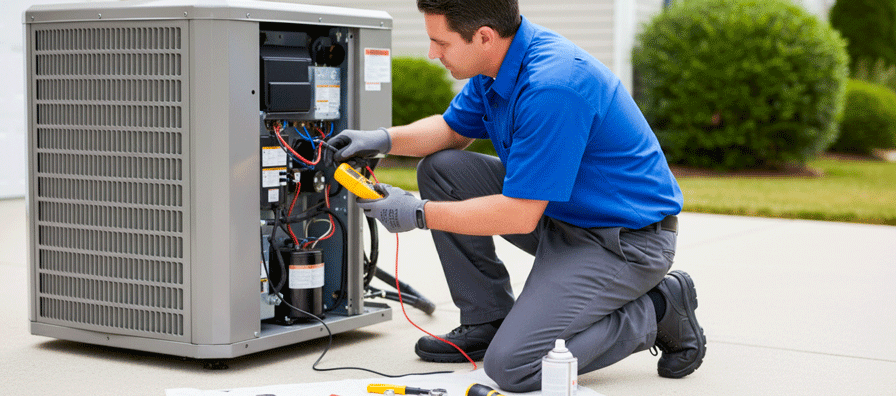
Applying proper repair methods and safety procedures will protect you and your equipment. Following the systematic troubleshooting process will lead you to the precise problem and determine if you can make the repair.
Safety Precautions Before Starting Any AC System Repair
Always turn off the power to the junction box (at the thermostat) and the outdoor disconnect box before attempting any AC system repair. Once you have turned the power off, confirm it’s off with a non-contact voltage tester.
When handling sharp metal components, wear safety glasses and work gloves. Never defeat any safety switch or attempt repair of pressurized refrigerant lines.
Troubleshooting Common Air Conditioner Parts
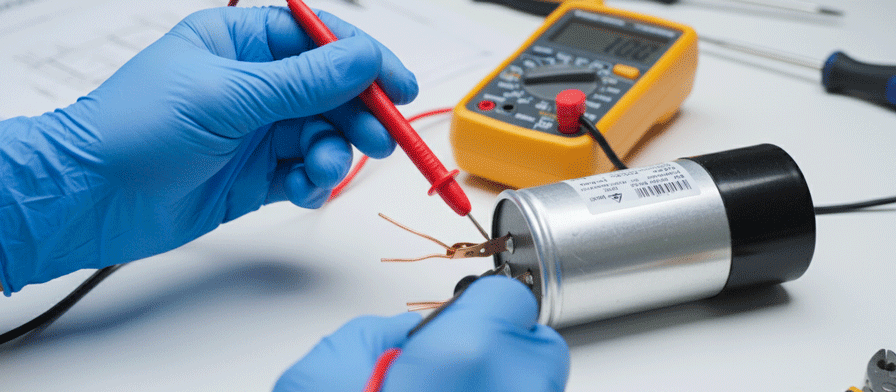
Checking AC unit parts entails employing simple tools and having safety knowledge for the accurate analysis of problems before contacting a repairman.
To test the capacitor:
- The capacitor needs to be discharged using an insulated screwdriver across the terminals
- Check the reading on the multimeter against the microfarad rating
- If the reading is 10% below the rating or more, replace the capacitor
The thermostat can be tested:
- New batteries should be replaced, or the contacts should be cleaned with compressed air
- Check all wires for looseness and corrosion
- You should compare the temperatures you see against a calibrated thermometer
- You can also test the system by manually turning the system on and off.
When to Replace vs. When to Repair
Consider replacement if the cost of repairs exceeds fifty percent of the cost of a new part, or if the unit is over ten years old. By taking into consideration the age, condition, and ac unit parts, you can more easily assess which is the more cost-efficient repair option.
In most instances, it is worth it to make minor repairs such as replacing a contactor or a capacitor, or both, no matter the age of the system. However, if you are contemplating replacing the compressor or coils on a unit older than twelve years, it is more budget-wise to replace the entire unit instead.
Using a Professional for Complex HVAC System Components
Only specially-certified technicians can legally handle refrigerant and related piping, and homeowners should never attempt to repair anything that involves touching refrigerant lines, even if they have been professionally trained in refrigerant handling; doing so voids your warranty.
Complex electrical diagnostics and replacements of major components require professional judgment, especially when it comes to companies like us, AC Maintenance UAE, that specialize in ac installation and repair services. Improper installation of replacement parts can cause a unit to fail quickly and create a dangerous condition for your home.
Maintenance Tips to Prevent Future AC System Repairs

Proactive maintenance applies a systematic method of approaching the process of minimizing failure, extending the working life of equipment, protecting your investment, and permitting dependable cooling performance throughout the season.
Regular Maintenance/General Cleaning and Filter Exchange
Disposable filters should be changed every 30-90 days according to household conditions, such as the importance of cleanliness due to age, allergies, or pets. Permanent filters should be cleaned with mild detergent every month.
Have the outdoor unit free of all vegetation, and trim bushes and remove leaves, all to accommodate at least a 2-foot separation from air flow.
Seasonal HVAC Inspection and Tune-Ups
Ensure you have professional maintenance completed every 6 months prior to cooling, and then again prior to heating season. Technicians will do AC deep cleaning, test refrigerant levels, and clean and lubricate moving parts (vent motor).
Spring tune-ups will catch problems ahead of summer heat when system demands are at their peak. Fall inspections ensure other heating components will also work properly, and will determine if there are potential heating emergencies that can be addressed before winter weather.
Keeping an Accurate and Up-to-Date AC Parts Name List for Ease of Replacement
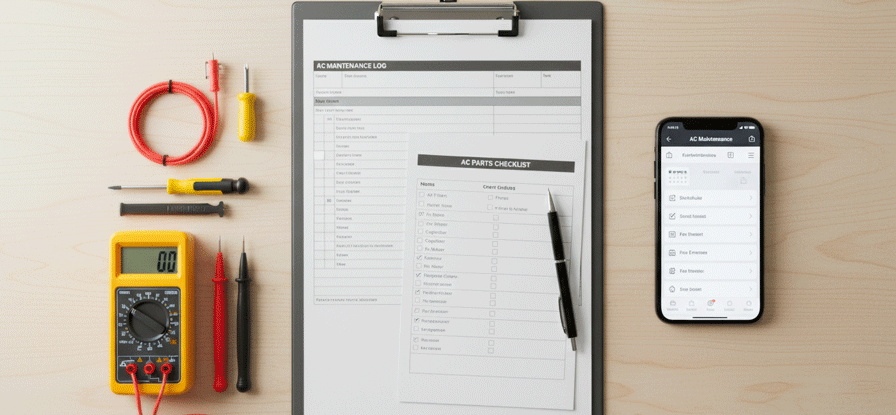
Keep a log of the make and model, and serial number of your system, to aid any technician’s replacement order for the correct parts picture quickly if the need arises.
Keep an ongoing AC parts name list of your unit with easily found information, starting with:
- Size and MERV rating of your filter
- The microfarad ratings (in line with size) of the capacitor,
- The model number of the thermostat
- If R-22 or R-410A refrigerant charges were normally added or were planned to be added for refrigerant.
- Any belt sizes, for example, that you may have for an older unit.
FAQs
Q1. What are the most commonly failing parts of an air conditioning unit?
Capacitors, contactors, and fan motors experience the most frequent failure. Coils and compressors fail as well, but these parts are fairly expensive to replace.
Q2. How do homeowners know that air conditioning parts are failing?
Unusual noises, weak air flow, ice forming on the system, leaks, higher utility bills, and not cooling evenly are all signs that an air conditioning part is malfunctioning and needs to be inspected.
Q3. Should homeowners try to repair or do work on the air conditioning system themselves?
Changing the air filter is a safe and simple project that a homeowner can do on their own, but any electrical work or working with refrigerants requires training and should be done by a professional.
Q4. How often should I have the parts in my HVAC system printed to be inspected?
The HVAC system should be inspected professionally twice a year, but the homeowner can check the air filter each month and clean the outdoor unit each season.
Q5. Where do you find the complete name of AC unit parts for your specific model?
The owner’s manual and the manufacturer’s website will have the complete name and diagram if the model number is known from the data plate located on the system.
Conclusion: Keep Your AC Unit Parts in Top Condition for Long-Term Cooling
Recognizing common failure points among AC unit parts allows you to service your system proactively and identify issues early. Providing regular service, quick repairs, and knowing when to call a professional helps protect your investment and provides peace of mind that your air conditioner is working as designed.
When you are aware of warning signs and perform regular maintenance when indicated, you will lengthen the service life of important HVAC parts while saving yourself from costly emergency repairs. Your air conditioning system works hard to maintain comfort for you, and preventing sudden failures with good care goes a long way.
Now that you know how to spot and replace bad components, are you ready to improve your AC system’s performance and longevity?
Schedule Your Professional AC Inspection Today
AC Maintenance UAE Team
Welcome to AC Maintenance UAE, your reliable partner for complete air conditioning repair and maintenance services in Dubai, Sharjah, and Abu Dhabi. We are strongly dedicated to excellence and deliver efficient and reliable services to keep your cooling systems performing at their best.
- AC Maintenance UAE Teamhttps://acmaintenanceuae.com/author/ac_mainten_admin/
- AC Maintenance UAE Teamhttps://acmaintenanceuae.com/author/ac_mainten_admin/
- AC Maintenance UAE Teamhttps://acmaintenanceuae.com/author/ac_mainten_admin/
- AC Maintenance UAE Teamhttps://acmaintenanceuae.com/author/ac_mainten_admin/

